Texas is home to a remarkable variety of wild cats, each contributing to the state’s rich biodiversity.
These species embody the diverse ecosystems that thrive across Texas landscapes.
From the elusive ocelot to the resilient bobcat, these species embody the diverse ecosystems that thrive across Texas landscapes.
If you’re curious about these fascinating felines and their behaviors, habitats, and conservation challenges, you’re in the right place.
As you explore wild cats in Texas, you’ll discover how historical factors and human interactions have shaped their populations.
With habitats ranging from dense forests to arid deserts, these cats have adapted to survive in some of the most unique environments, making them an integral part of Texas’s natural heritage.
Understanding the role of these wild cats goes beyond admiration; it highlights the importance of conservation efforts to protect their habitats.
As you read, you’ll gain insights into the challenges they face and what can be done to ensure their survival in a world that often puts them at risk.
Key Takeaways
- Texas hosts a variety of wild cats, each with unique characteristics.
- Conservation efforts are crucial for the survival of these species.
- Human interaction significantly impacts their populations and habitats.
History of Wild Cats in Texas
Wild cats have a rich history in Texas, shaped by indigenous populations and changing environments.
Understanding their past helps illuminate their current status and the efforts to conserve them.
Native Species and Migrations
Texas is home to several wild cat species, including the bobcat, ocelot, jaguarundi, and historically, the jaguar and mountain lion.
- Bobcats are adaptable and thrive across the state.
- Ocelots, more specialized, prefer dense cover and are mostly found in southern Texas.
- The jaguarundi, which resembles a house cat, has seen diminishing numbers, with its last confirmed sighting about 40 years ago.
These species migrated into Texas as climate and landscapes evolved.
The lush habitats provided ample prey and shelter, allowing populations to flourish until more recent human encroachments altered their environments.
Conservation Status and Efforts
Wild cats in Texas face various threats, primarily habitat loss and illegal hunting.
The bobcat remains stable due to its adaptability, while the ocelot and jaguarundi are classified as threatened.
Conservation efforts focus on habitat protection and educational outreach.
- Organizations like Texas Native Cats advocate for these felines, highlighting their importance in the ecosystem.
- Efforts also include monitoring populations and enforcing regulations against poaching.
With ongoing conservation initiatives, there’s hope for the future of these iconic Texas cats.
Physical Characteristics of Texas Wild Cats
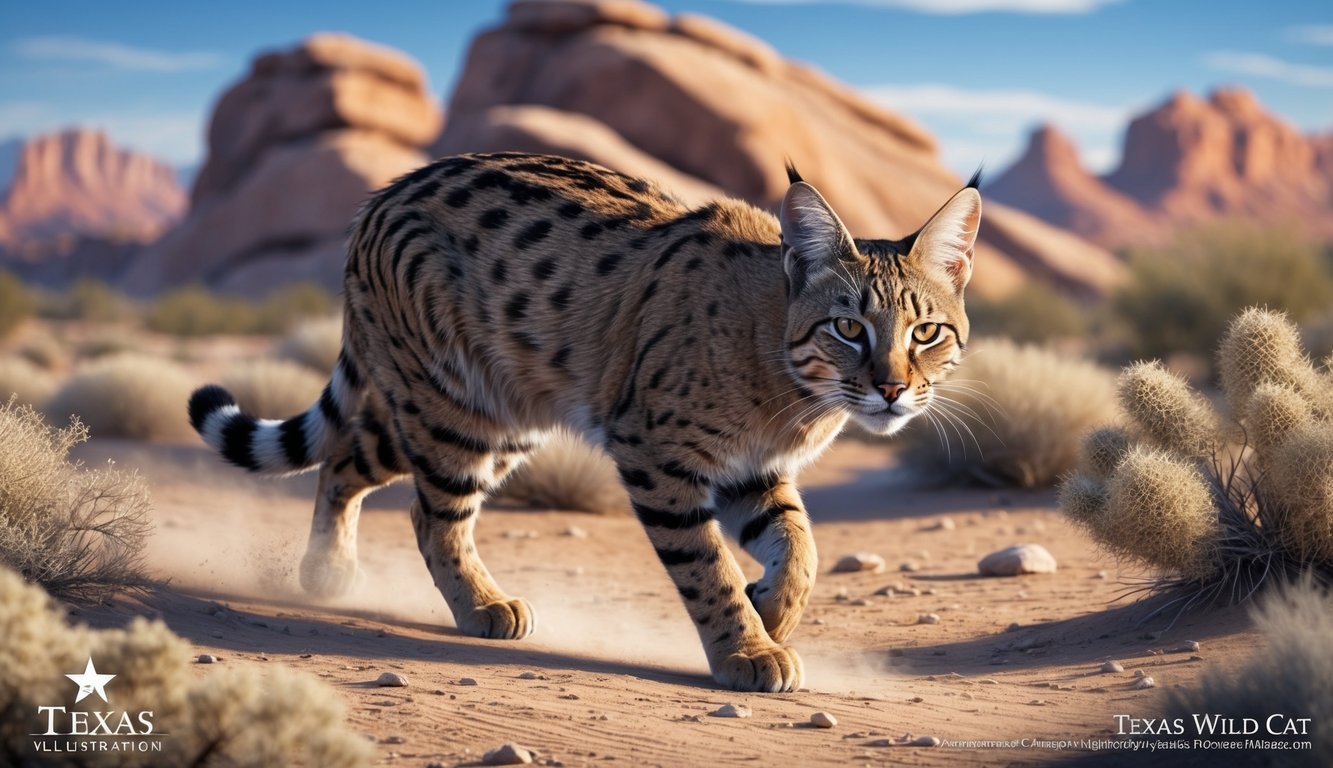
Texas is home to a variety of wild cats, each with unique features that help them thrive in diverse habitats.
Understanding these physical traits provides insight into how they adapt and survive in the Texas landscape.
Spot and Stripe Patterns
Texas wild cats exhibit distinct patterns that serve as camouflage.
The bobcat is known for its spotted fur, which aids it in blending with the brushy terrain.
This pattern helps it hunt effectively, as the spots mimic the dappled light and shadows in its environment.
The ocelot, another native cat, displays beautiful spots and stripes.
These features not only enhance its aesthetic appeal but also provide essential concealment when stalking prey.
The ocelot’s coat allows it to remain undetected in the dense underbrush and grasslands of Texas.
Adaptations to the Texas Environment
Wild cats in Texas have developed several physical adaptations to thrive in the state’s diverse climates.
For instance, the mountain lion has a robust and muscular build, which is ideal for its solitary hunting style across vast territories.
Its long legs allow for powerful jumps and quick sprints to catch prey.
Short tails, like those seen in bobcats, serve a functional purpose.
They aid in balance and maneuverability, especially in rough terrain.
Additionally, these cats’ ear tufts improve their hearing by helping to funnel sound, allowing them to detect even the faintest movements in their surroundings.
In summary, these physical characteristics not only showcase the beauty of Texas wild cats but also highlight their evolutionary success in adapting to a challenging environment.
Behavior and Ecology
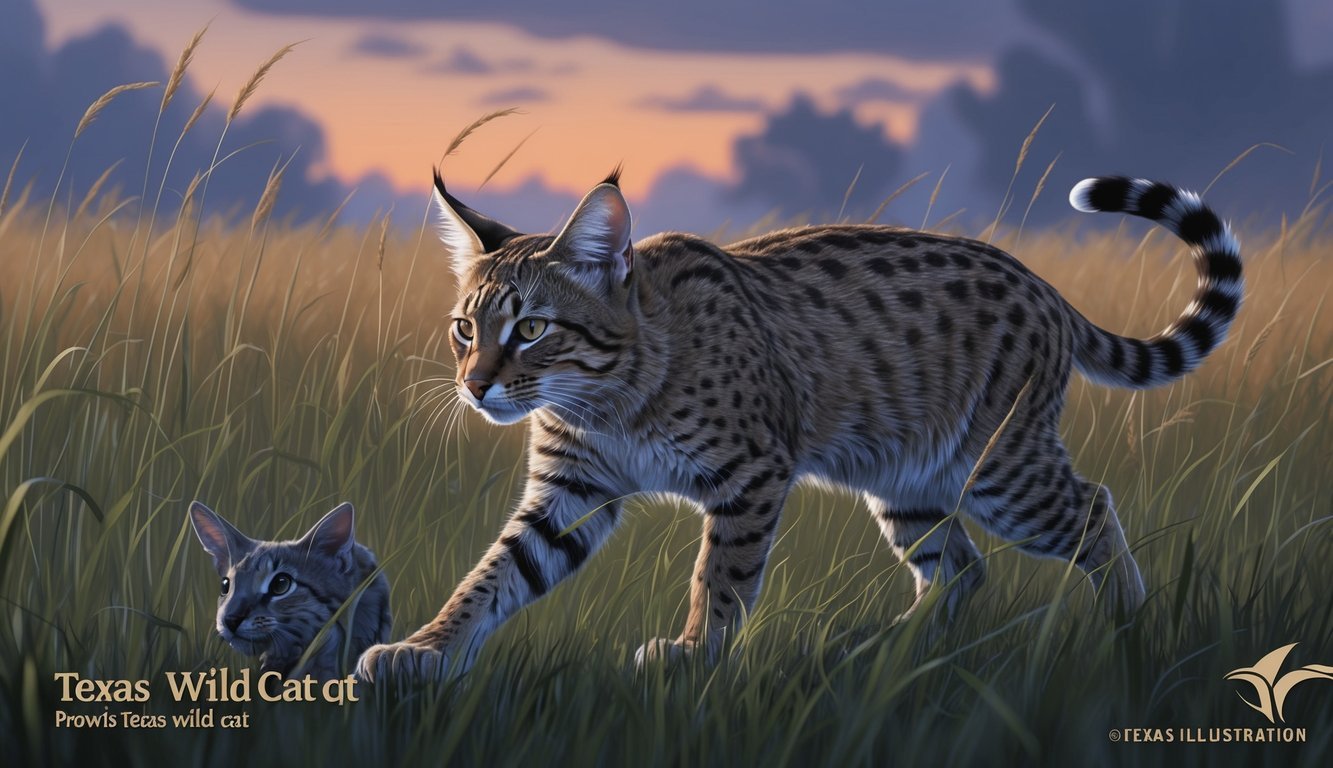
When exploring how Texas wild cats function within their environment, consider their territorial habits, diet, and reproductive behaviors.
These aspects play vital roles in their survival and adaptation.
Territorial Habits and Ranges
Texas wild cats are predominantly territorial and use scent marking to establish their boundaries.
They rely on urine and scratch marks to communicate with others and deter intruders.
Ranges vary significantly among species.
For instance, bobcats typically occupy territories ranging from 1 to 20 square miles, depending on prey availability.
They are generally solitary animals, preferring to find shelter in dense vegetation or rocky areas.
During the day, you might find them resting in dense underbrush, only to become active at night.
Diet and Hunting Methods
As nocturnal predators, Texas wild cats primarily hunt at night.
Their diet mainly consists of small mammals, including rabbits, rodents, and even birds.
When hunting, they rely on stealth and patience, often stalking their prey for long distances. Hunting techniques include using cover to ambush and employing powerful jumps to pounce on unsuspecting animals.
These cats are also opportunistic feeders, adjusting their diet based on the availability of prey.
This adaptability increases their chances of survival in varying habitats across Texas.
Reproductive Behaviors
Reproduction typically occurs in the spring for Texas wild cats.
Mating rituals involve vocalizations, scent marking, and physical displays to attract potential mates.
After a gestation period of about 60 to 70 days, females give birth to litters of 1 to 6 kittens.
They often choose secluded locations to raise their young, providing safety from predators.
Kittens start to venture out with their mother around two months old, learning essential skills like hunting and territory navigation.
This early training is crucial for their success in the wild.
Habitats of Texas Wild Cats
Texas boasts diverse habitats that support various wild cat species.
Understanding these environments helps highlight how these animals adapt to their surroundings and the challenges they face.
Desert and Arid Regions
In the arid regions of Texas, you’ll find wild cats like the bobcat and the elusive ocelot.
These cats are well-suited to desert environments, characterized by sparse vegetation and dramatic temperature changes.
They primarily hunt small mammals, birds, and reptiles, utilizing the cover provided by cacti and shrubs.
Key features of these habitats:
- Adaptation to Dry Conditions: Cats have developed behavioral adaptations to conserve water and hunt effectively.
- Diverse Prey Availability: Insects and small rodents thrive in these areas, providing a steady food source for wild cats.
Forested Areas and Thick Brush
Forested regions of Texas create a rich habitat for wild cats like the ocelot and mountain lion.
These areas offer dense vegetation, which provides cover and hunting grounds.
You’ll find these cats using their keen senses to stalk prey such as deer and rabbits.
The thick underbrush is crucial, as it conceals them from both prey and human threats.
Characteristics of these habitats include:
- High Biodiversity: The vegetation supports a range of animals, offering ample food.
- Territorial Marking: Cats use scent marking to communicate with others and establish territory.
Adaptation to Urban Expansion
As urban areas expand, wild cats face increasing challenges.
Adapting to human-dominated landscapes is critical for survival, especially for species like the bobcat.
These cats learn to navigate neighborhoods, parks, and even golf courses in search of food.
They hunt small animals attracted to suburban environments, such as rodents or birds.
Key adaptations include:
- Increased Mobility: Cats adjust their hunting patterns and activity times to avoid peak human activity hours.
- Usage of Green Spaces: Parks and greenbelts become essential corridors for these cats to maintain connectivity with natural habitats.
Human Interaction With Wild Cats
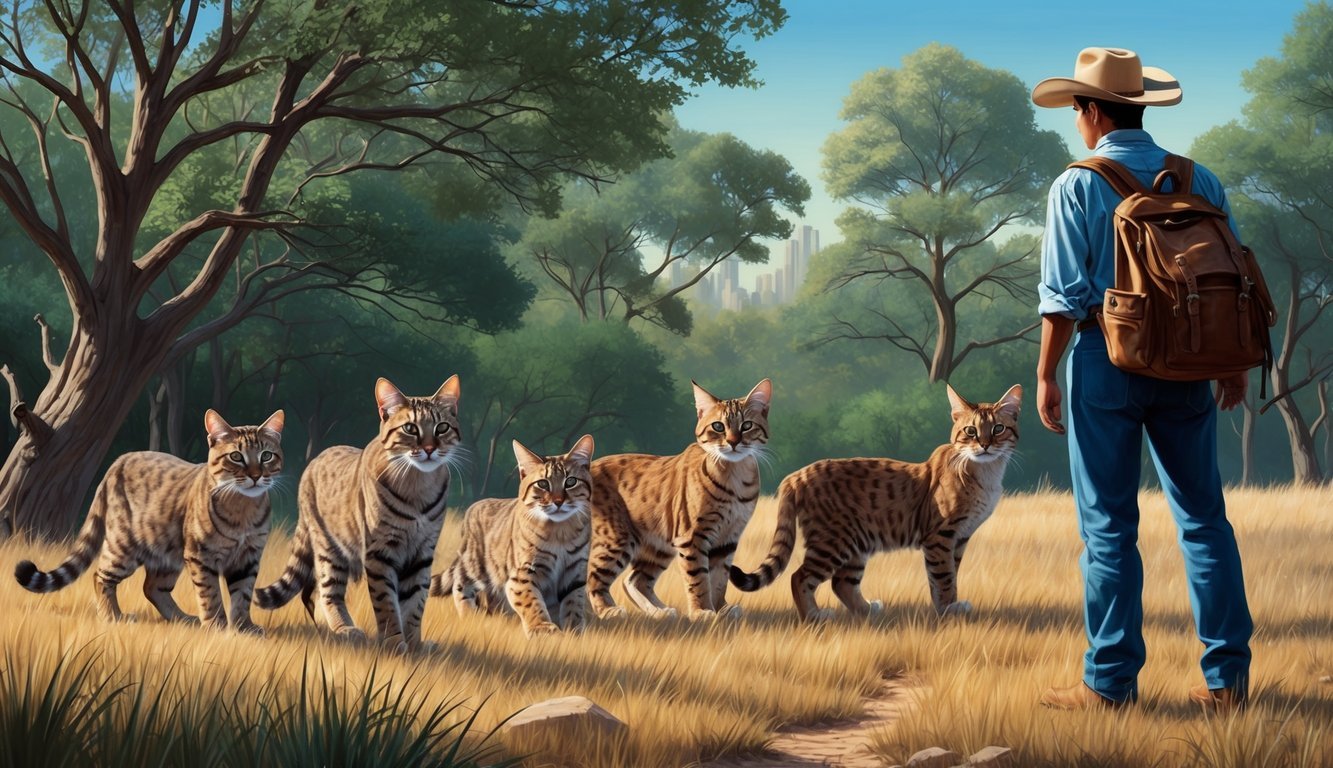
Understanding your interaction with wild cats is essential for promoting safety and coexistence.
By being informed about potential risks and recognizing the economic influence these animals have, you can help foster a balanced relationship with Texas’ native cats.
Safety and Coexistence
When living near habitats of wild cats, such as the bobcat, it’s important to prioritize safety.
While these cats are generally elusive, encounters can happen, especially in urban areas where their natural habitats are encroached upon.
To reduce human-wildlife conflicts, secure trash bins and avoid leaving pet food outside.
If you spot a wild cat, remain calm and back away slowly.
Avoid feeding or approaching these animals, as that can encourage them to frequent human spaces.
Trapping may be necessary in some cases, especially if a wild cat poses a risk to pets or livestock.
Contact local wildlife authorities for guidance.
Awareness and respect for their territory lead to safer interactions.
Economic Impact of Wild Cats
Wild cats in Texas, including bobcats and other native species, play a significant role in the local economy.
Ecotourism focused on wildlife watching has grown, attracting visitors eager to see these elusive felines in their natural habitats.
On the other hand, predation from wild cats can impact livestock and poultry operations.
To mitigate financial losses, farmers may use fencing or guard animals.
Collaboration between wildlife agencies and locals promotes economic strategies that benefit both parties.
Through education and advocacy, communities can learn best practices for living alongside wild cats.
This fosters a sustainable economy while ensuring the protection of these important species.
Conservation Challenges and Initiatives
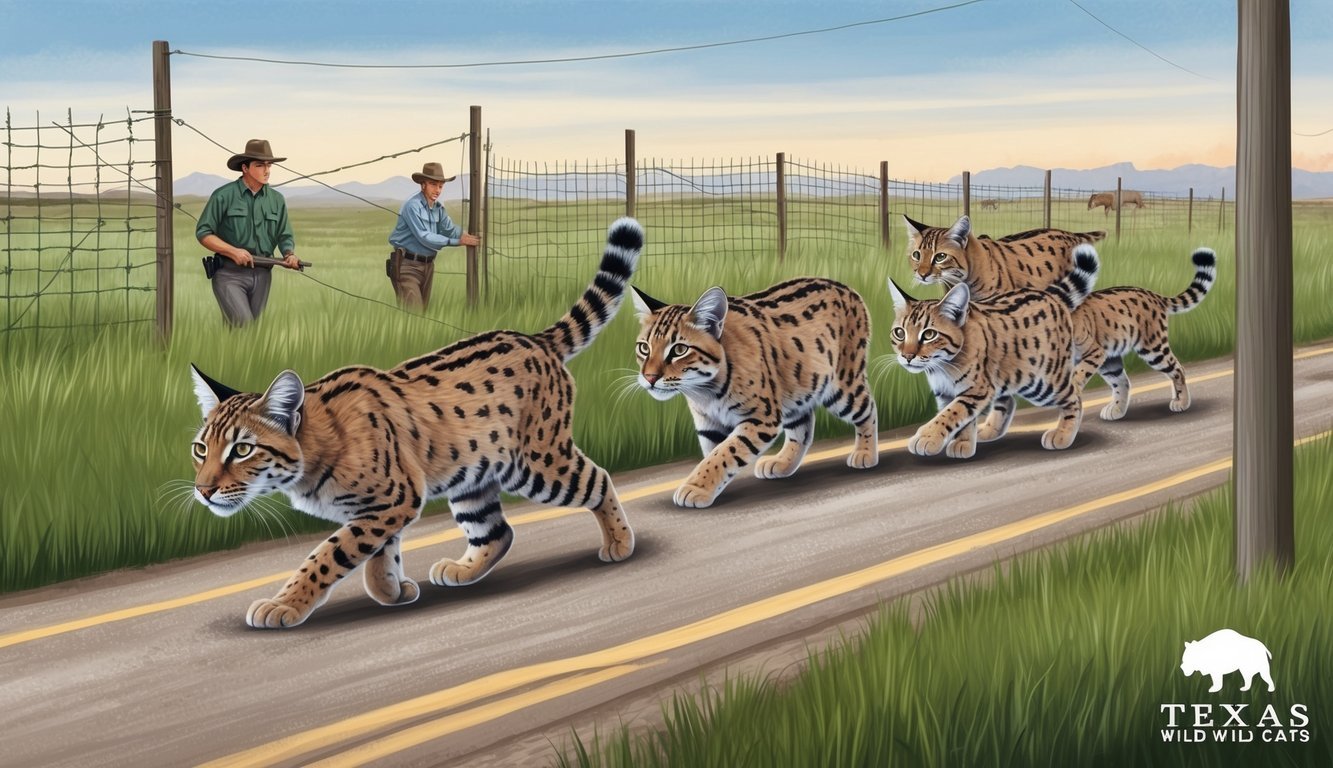
Texas wild cats, including pumas and ocelots, face significant threats to their survival.
Conservation measures are critical to address their declining populations and protect their habitats.
Here are some key initiatives and challenges.
Legislation and Protection Measures
Various laws aim to safeguard Texas wild cats.
The Endangered Species Act helps protect ocelots, which are federally listed as endangered.
This legislation restricts habitat destruction and encourages conservation efforts.
Additionally, the Texas Wildlife Action Plan outlines strategies for managing and restoring habitat for these animals.
Various agencies, including the Texas Parks and Wildlife Department, play a role in enforcing these protections.
Local partnerships also enhance conservation.
Organizations like Texas Native Cats focus on education and outreach, fostering community involvement in protection initiatives.
You can support these efforts by advocating for stronger wildlife protections and participating in local conservation events.
Captive Breeding and Rehabilitation
Captive breeding programs are essential for the recovery of endangered species like the ocelot.
These initiatives help increase genetic diversity and support population growth.
For instance, partnerships with facilities in Mexico have facilitated the exchange of knowledge and genetic material to boost ocelot numbers.
Rehabilitation efforts also address injured or orphaned wild cats, increasing their chances of returning to the wild.
Programs focus on wildlife corridors to connect fragmented habitats and allow safe passage for cats.
Community involvement is vital.
Engaging with local conservation groups and supporting rehabilitation centers can help ensure these wild cats have a future in Texas.
By understanding these initiatives, you can contribute to the preservation of Texas’s unique feline species.
Wild Cats’ Role in the Ecosystem

Wild cats play an essential part in maintaining the balance of their ecosystems.
They help control prey populations while interacting with other predators, which shapes the environment significantly.
Impact on Prey Populations
Wild cats, such as bobcats and ocelots, are significant predators in Texas ecosystems.
They hunt small mammals, birds, and reptiles, helping regulate these populations.
Without these predators, prey species could multiply unchecked, leading to overgrazing and depletion of vegetation.
This imbalance can negatively affect other wildlife, including birds and amphibians, which depend on healthy plant life for shelter and food.
For example, a robust vegetation cover supports various bird species by providing nesting sites and resources.
Additionally, predation helps maintain genetic health in prey populations by removing weaker individuals.
This natural selection process ensures the survival of the fittest, contributing to the overall biodiversity of the area.
Interactions with Other Predators
Wild cats also interact with other predators, creating a complex web of relationships in the ecosystem.
Their presence can influence the behavior of other carnivores, like coyotes or foxes.
In some instances, wild cats may compete with these predators for the same prey.
This competition can lead to changes in hunting strategies or territory usage among the different species.
The interactions may also enhance the entire ecosystem’s health.
For instance, as wild cats hunt, they can create opportunities for scavengers, ensuring that nutrients cycle through the environment more effectively.
Frequently Asked Questions
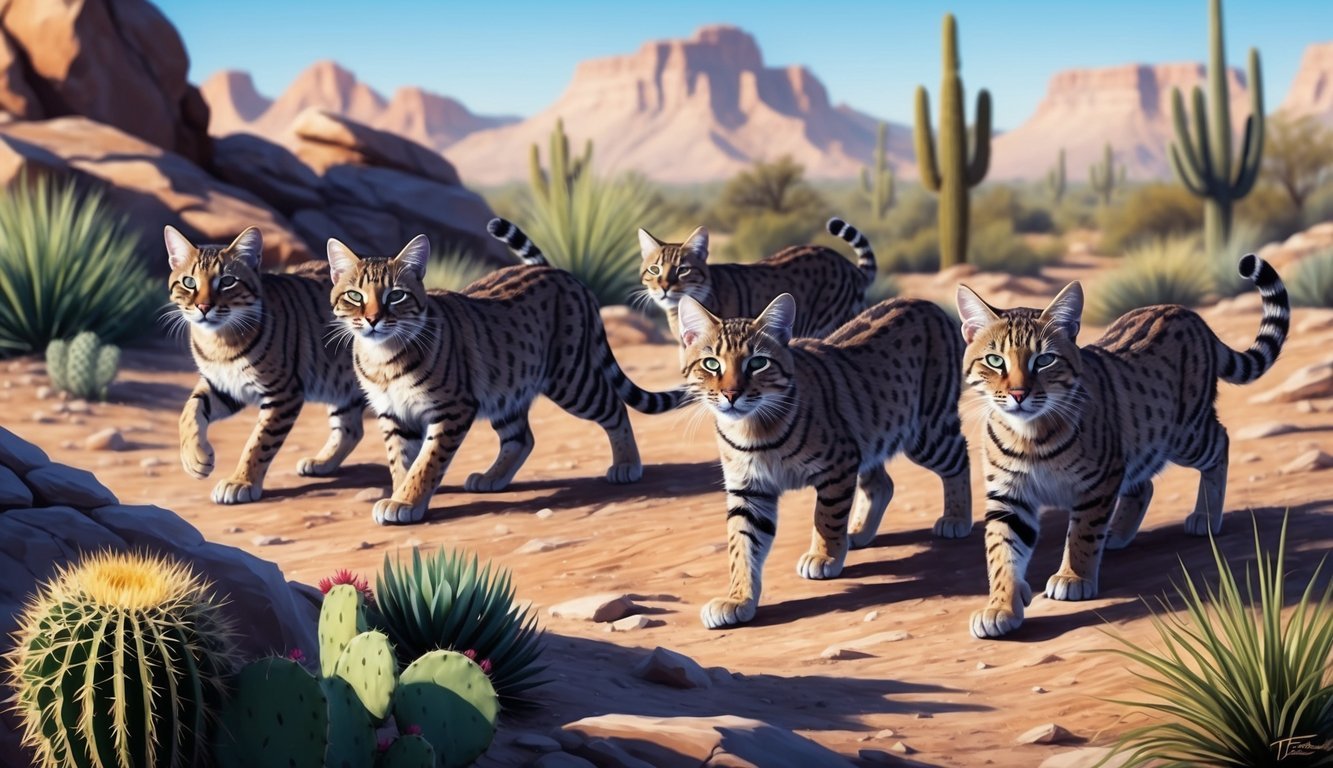
You likely have questions about the wild cats that roam Texas.
From bobcats to smaller species, there’s a rich diversity of feline wildlife in the state.
Let’s explore some common queries.
What kind of wild cats can you find in Texas?
Texas is home to several wild cat species.
The most notable are bobcats and ocelots.
Jaguarundis also inhabit Texas, although sightings are rare.
These species contribute to the diverse wildlife of the state.
Are there any bobcats or lynx roaming around Texas?
Yes, bobcats are abundant throughout Texas.
They are highly adaptable and can thrive in various habitats.
However, lynx are not found in Texas; they mainly inhabit areas in the northern U.S. and Canada.
Just how big do the ocelots in Texas get?
Ocelots in Texas typically weigh between 20 to 35 pounds.
They stand about 14 to 15 inches tall at the shoulder.
Their size makes them smaller than bobcats but larger than many domestic cats.
Have there been any sightings of jaguars in Texas?
Jaguars have been extinct in Texas since 1948, primarily due to habitat loss.
There are occasional unverified reports of jaguar sightings, particularly along the southern border, but these are not confirmed.
Could you tell me about the smaller wild cats that live in Texas?
In addition to ocelots, Texas is home to the jaguarundi and the endangered Texas wildcat.
These smaller species often go unnoticed but play essential roles in their ecosystems.
Do Texas wild cats typically have long tails, and where can I see pictures?
Most Texas wild cats, like bobcats and ocelots, possess relatively long tails.
You can find pictures of these felines on wildlife photography websites and conservation organization pages.
These sites often showcase their beauty and habitat.

